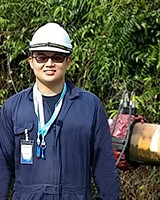PhD student, 2016 intake
University: Imperial College London
Sponsoring company: Guided Ultrasonics Ltd. (GUL)
Background: MEng Chemical Engineering, Imperial College London
If permanently installed monitoring systems are to be practical, unless the defect location of concern is known precisely, it is important that each transducer can cover a significant area of structure. In guided wave corrosion monitoring it has been shown that taking frequent readings gives a factor of ~5 improvement in sensitivity compared to conventional one-off NDT. This suggests that area coverage in crack monitoring could be achieved at lower inspection frequencies, and hence greater volume coverage per transducer, than are used in conventional inspection.
This project will take two typical test cases e.g. girth welds in 10mm and 100mm wall pipes and develop systems for crack growth rate monitoring. It is likely that the thin wall case will use guided waves, possibly in the standard pipe test range below 100 kHz, but more likely in the 200 kHz range – this will depend on the crack size that must be found and the success of baseline subtraction and associated strategies; the thick wall case will probably require bulk waves. In both cases an EMAT transduction approach is likely to be used and the project will develop this, together with modelling the interaction with defects and system trials over multiple environmental cycles.



